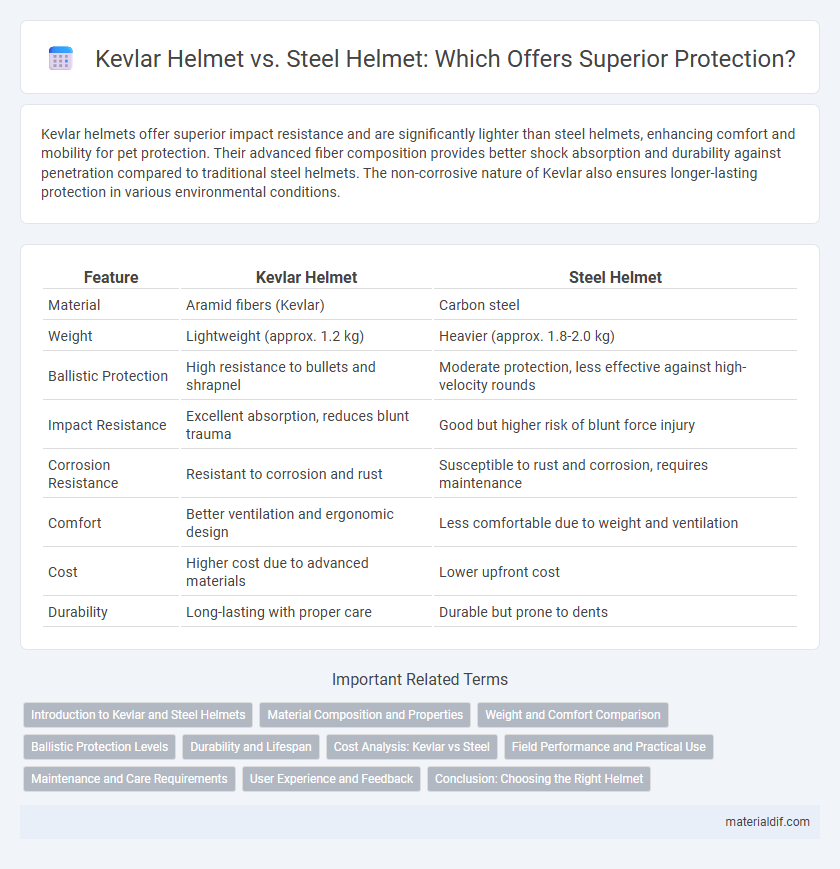Kevlar helmets offer superior impact resistance and are significantly lighter than steel helmets, enhancing comfort and mobility for pet protection. Their advanced fiber composition provides better shock absorption and durability against penetration compared to traditional steel helmets. The non-corrosive nature of Kevlar also ensures longer-lasting protection in various environmental conditions.
Table of Comparison
| Feature | Kevlar Helmet | Steel Helmet |
|---|---|---|
| Material | Aramid fibers (Kevlar) | Carbon steel |
| Weight | Lightweight (approx. 1.2 kg) | Heavier (approx. 1.8-2.0 kg) |
| Ballistic Protection | High resistance to bullets and shrapnel | Moderate protection, less effective against high-velocity rounds |
| Impact Resistance | Excellent absorption, reduces blunt trauma | Good but higher risk of blunt force injury |
| Corrosion Resistance | Resistant to corrosion and rust | Susceptible to rust and corrosion, requires maintenance |
| Comfort | Better ventilation and ergonomic design | Less comfortable due to weight and ventilation |
| Cost | Higher cost due to advanced materials | Lower upfront cost |
| Durability | Long-lasting with proper care | Durable but prone to dents |
Introduction to Kevlar and Steel Helmets
Kevlar helmets, crafted from high-strength synthetic fibers, offer superior ballistic protection while remaining lightweight and resistant to shrapnel and blunt impact. Steel helmets, made from hardened steel, provide durable defense but are significantly heavier and less effective against modern ballistic threats. Kevlar's advanced composition ensures enhanced comfort and mobility compared to the traditional steel helmets used in earlier military applications.
Material Composition and Properties
Kevlar helmets are composed of aramid fibers known for high tensile strength and lightweight durability, offering superior impact resistance and energy absorption compared to steel helmets. Steel helmets, made from carbon steel or stainless steel, provide robust protection against penetration but are significantly heavier and less effective at dissipating blunt force trauma. Kevlar's corrosion resistance and flexibility enhance wearer comfort and long-term durability, making it the preferred material for modern ballistic helmets.
Weight and Comfort Comparison
Kevlar helmets weigh approximately 40% less than traditional steel helmets, significantly reducing fatigue during extended use. The lightweight nature of Kevlar enhances comfort by improving breathability and fit, allowing for longer wear without discomfort. Enhanced ergonomic design combined with Kevlar's flexible aramid fibers provides superior shock absorption while maintaining low weight.
Ballistic Protection Levels
Kevlar helmets offer superior ballistic protection compared to steel helmets, effectively stopping fragments and low-velocity projectiles due to their advanced aramid fiber composition. Steel helmets primarily provide blunt force protection but often fall short against high-velocity shrapnel and bullets categorized under NIJ Level IIIA standards. Modern tactical units favor Kevlar helmets for their lightweight durability and enhanced resistance to penetration, increasing soldier survivability in combat zones.
Durability and Lifespan
Kevlar helmets offer superior durability compared to steel helmets due to their high tensile strength and resistance to impact and abrasion. Kevlar fibers maintain structural integrity under extreme conditions, resulting in a longer lifespan without significant degradation or corrosion like steel helmets. This enhanced durability makes Kevlar helmets a preferred choice for extended use in demanding environments.
Cost Analysis: Kevlar vs Steel
Kevlar helmets typically cost between $300 and $600, significantly higher than steel helmets, which range from $50 to $150. The increased price of Kevlar helmets reflects their advanced ballistic protection, lightweight design, and superior durability compared to heavier, less protective steel helmets. Investing in Kevlar helmets reduces long-term costs associated with fatigue-related injuries and helmet replacements, making them more cost-effective over time despite the higher initial expense.
Field Performance and Practical Use
Kevlar helmets provide superior ballistic protection and are significantly lighter than steel helmets, reducing fatigue during extended field operations. Their enhanced shock absorption minimizes blunt force trauma, improving soldier safety in combat scenarios. Steel helmets, while durable against sharp objects, are heavier and less effective against modern ballistic threats, making Kevlar the preferred choice for practical military use.
Maintenance and Care Requirements
Kevlar helmets require less frequent maintenance compared to steel helmets due to their resistance to corrosion and rust. The polymer fibers in Kevlar maintain structural integrity without regular repainting or anti-rust treatments. Steel helmets demand consistent inspection for dents and corrosion, along with proper cleaning and protective coatings to extend their lifespan.
User Experience and Feedback
Kevlar helmets offer significantly enhanced user comfort compared to steel helmets due to their lightweight design, reducing neck strain during prolonged use. Feedback from military and law enforcement personnel highlights Kevlar's superior impact absorption and resistance to ballistic threats, increasing confidence in protection without compromising mobility. While steel helmets provide robust defense, users often report Kevlar helmets as more breathable and adaptable for various operational environments.
Conclusion: Choosing the Right Helmet
Kevlar helmets provide superior ballistic protection and are significantly lighter than steel helmets, enhancing comfort and reducing fatigue during prolonged wear. Steel helmets offer excellent resistance to blunt force trauma and are generally more affordable but weigh more and provide less protection against high-velocity projectiles. Selecting the right helmet depends on specific operational requirements, balancing protection level, weight, and budget constraints.
Kevlar helmet vs Steel helmet Infographic

 materialdif.com
materialdif.com